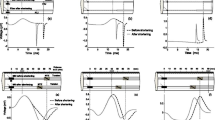Summary
The sizes and population density of intramembrane particles in the non-myelinated sensory nerve terminals of frog muscle spindles were studied in comparison with changes in the responses to spindles to stretch 1–28 days after denervation. The sciatic nerve in the right leg was cut at the dorsal part of the hip joint. Spindle receptors in the left leg were used as controls. Muscle spindles were isolated from semitendinosus and iliofibularis muscles. The mean density of particles, which occurred mainly on the protoplasmic (P) face, declined rapidly to 60% of the control values 2 days after denervation, 30% after 4 days and to less than 10% after 7 days. The mean diameter of particles changed from 8.0 ± 1.5 nm in the control to 12.8 ± 2.5 nm 7 days after denervation. No significant difference between the results for the trunks (> 2 μm in diameter) and the branches (< 0.5 μm) of the non-myelinated axons was observed. The peak rate of afferent discharges during a ramp- and-hold stretch survived up to 4 days after denervation, whereas the static component disappeared after 3 days. It is suggested that the decline to less than 20% of the control density of particles removes the mechanosensitivity of the sensory endings.
Similar content being viewed by others
References
Boyd, I. A. &Rosenberg, J. R. (1985) Ionic events associated with spindle receptor potential. InThe Muscle Spindle (edited byBoyd, I. A. &Gladden, M. H.), pp. 327–52. London: Macmillan.
Bray, G. M., Peyronnard, J.-M. &Aguayo, A. J. (1972) Reactions of unmyelinated nerve fibres to injury. An ultrastructural study.Brain Research 42, 297–309.
Brown, M. C. &Butler, R. G. (1976) Regeneration of afferent and efferent fibres to muscle spindles after nerve crush injury in adult cats.Journal of Physiology 260, 253–66.
Dyck, P. J. &Hopkins, A. P. (1972) Electron microscopic observations on degeneration and regeneration of unmyelinated fibres.Brain 95, 223–34.
Flower, N. E. (1971) Particles within membranes — A freeze-etch view.Journal of Cell Science 9, 435–41.
Fujitsuka, N. &Ito, F. (1983) Uptake of ruthenium red by the sensory nerve terminal of the frog muscle spindle.Okajimas Folia Anatomica Japonica 60, 1–16.
Fukami, Y. (1972) Electrical and mechanical factors in the adaptation of reinnervated muscle spindles in snake. InResearch in Muscle Development and the Muscle Spindle (edited byBanker, B. Q., Przybylski, R. J., Van Der Meulen, J. P. &Victor, M.), pp. 379–99. Amsterdam: Excerpta Medica.
Fukami, Y. &Ridge, R. M. A. P. (1971) The effects of chronic denervation on spindle discharge patterns and morphology in isolated costocutaneous muscles of garter snakes.Journal of Comparative Neurology 143, 137–56.
Hyde, D. &Scott, J. J. (1983) Responses of cat peroneus brevis muscle spindle afferents during recovery from nerve-crush injury,Journal of Neurophysiology 50, 344–57.
Ito, F., Fujitsuka, N. &Fan, X. L. (1985a) Reversal of the static component of spindle potential by imposed depolarizing current in the frog muscle spindle.Brain Research 326, 107–16.
Ito, F., Fujitsuka, N., Funahashi, A. &Hama, K. (1985b) Ionic channels in the sensory terminal of the frog muscle spindle. InThe Muscle Spindle (edited byBoyd, I. A. &Gladden, M. H.), pp. 353–8. London: Macmillan.
Ito, F. &Komatsu, Y. (1977) Frog muscle spindles with unbranched myelinated afferent axons: the response to stretch and the length of the first myelinated segment.Journal of Physiology 264, 881–91.
Ito, F. &Komatsu, Y. (1979) Calcium-dependent regenerative responses in the afferent nerve terminal of the frog muscle spindle.Brain Research 175, 160–4.
Ito, F., Komatsu, Y. &Fujitsuka, N. (1982) GK(Ca) − dependent cyclic potential changes in the sensory nerve terminal of frog muscle spindle.Brain Research 252, 39–50.
Ito, F., Komatsu, Y. &Kaneko, N. (1980) Site of origin of calcium spike in frog muscle spindle.Brain Research 202, 459–63.
Karlsson, U. L., Hooker, W. M. &Bendeich, E. G. (1971) Quantitative changes in the frog muscle spindle with passive stretch.Journal of Ultrastructure Research 36, 734–56.
Kristol, C., Sandri, C. &Akert, K. (1978) Intramembranous particles at the nodes of Ranvier of the cat spinal cord: a morphometric study.Brain Research 142, 391–400.
Peracchia, C. (1974) Excitable membrane ultrastructure. 1. Freeze fracture of crayfish axones.Journal of Cell Biology 61, 107–22.
Poo, M.-m. (1985) Mobility and localization of proteins in excitable membranes.Annual Review of Neuroscience 8, 369–406.
Quick, D. C. (1984) Freeze-fracture of sensory nerve endings in cat muscle spindles.Journal of Neurocytology 13, 975–87.
Schröder, J. M. (1974a) The fine structure of de- and reinnervated muscle spindles. I. The increase, atrophy and ‘hypertrophy’ of intrafusal muscle fibres.Acta neuropathologica 30, 109–28.
Schröder, J. M. (1974b) The fine structure of de- and reinnervated muscle spindles. II. Regenerated sensory and motor nerve terminals.Acta neuropathologica 30, 129–44.
Stuhmer, W. &Almers, W. (1982) Photobleaching through glass micropipettes: sodium channels without lateral mobility in the sarcolemma of frog skeletal muscle.Proceedings of the National Academy of Sciences USA 79, 946–50.
Tao-Cheng, J.-H., Hirosawa, K., Nakajima, Y. &.Peng, J. B. (1981) Freeze-fracture study of the crayfish stretch receptor.Journal of Comparative Neurology 200, 23–38.
Tao-Cheng, J.-H., &Rosenbluth, J. (1980) Nodal and paranodal membrane structure in complementary freeze-fracture replicas of amphibian peripheral nerves.Brain Research 199, 249–65.
Author information
Authors and Affiliations
Rights and permissions
About this article
Cite this article
Fujitsuka, N., Hama, K., Ito, F. et al. Intramembrane particles and terminal responses following denervation of frog muscle spindles. J Neurocytol 16, 185–194 (1987). https://doi.org/10.1007/BF01795302
Received:
Revised:
Accepted:
Issue Date:
DOI: https://doi.org/10.1007/BF01795302




